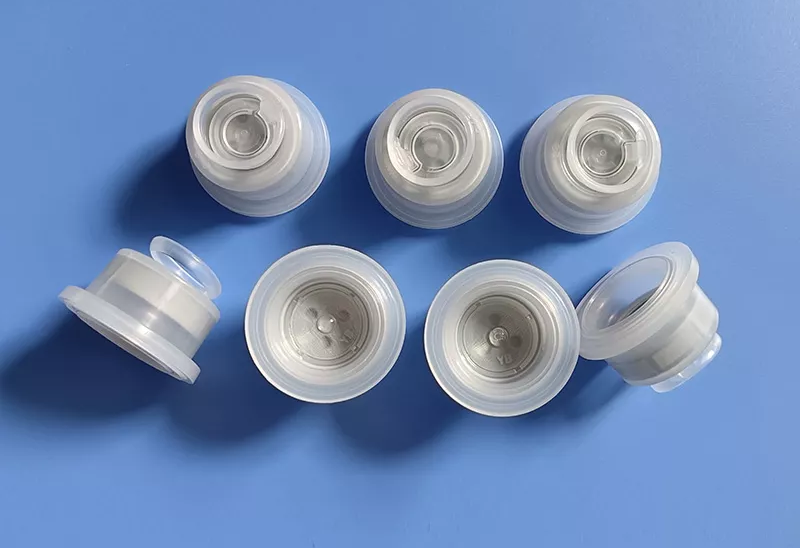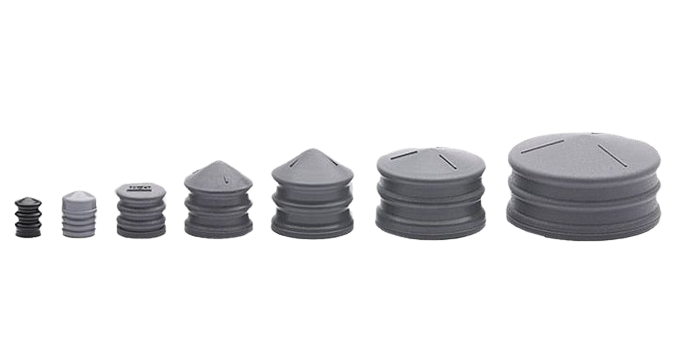Description
39mm PP Pharmaceutical Euro Caps For IV Infusion Bags
| Name | 39mm PP pharmaceutical euro caps
for iv infusion bags |
| Materials | High-density PP |
| Features | 1) Used for PP LV. bag
2) Ready-to-use Product 3) Excellent compatibility with the solution 4) Good welding property 5) Sterilization temperature up to 121 °C 6) Outer and inner caps are molded and assembled separately to avoid the mixture Production and packaging under A+C Grade Clean Room |
| Top Diameter (Euro Head Cap) | 34.0 mm + 0.3 mm |
| Bottom Diameter (Euro Head Cap) | 37.0 mm + 0.3 mm |
| Height (Euro Head Cap) | 274mm +0.3mm |
| Diameter (Rubber Disc) | 29.8 mm + 0.2mm |
| Thickness (Rubber Disc) | 5.0 mm + 0.25 mm |
PP Pharmaceutical Euro Caps For IV infusion Bags
| Name | PP pharmaceutical euro caps for iv infusion bags |
| Materials | High-density PP |
| Features | 1)Used for PP I.V. bag
2)Ready-to-use Product 3)Excellent compatibility with the solution 4)Good welding property 5)Sterilization temperature up to 121 °C 6)Outer and inner caps are molded and assembled separately to avoid mixture 7)Production and packaging under A+C Grade Clean Room |
| Size | 30°3MM 30°5MM 32*3MM |
Cartridge & Rubber Plungers
Local anesthesia is the fundamental part of the pain control technique where dental therapeutic progress has been possible thanks to the prevention and elimination of pain. Not only have new anesthetic drugs been developed, but also the components of the cartridges have been improved in order to allow a safer and pain free experience during dental procedures. The aim of this short article is to allow professionals to be familiar with dental cartridge components and thus to understand how the mechanics and components of the cartridge work.
Cartridge components
The dental cartridge consists of three parts (Fig. 1):
- Cylinder
- Plunger or stopper
- Cap
- The Cylinder
The cylinder is the main part of a dental cartridge. It is a cylindrical glass tube containing the local anesthetic drug and other excipients, closed by a plunger and a cap. While the diameter of the cylinder is the same, the cartridge length can be different depending on the volume of solution. In the United States and in many other countries, the standard is 1.8/1.7 mL. In the UK and Australia, the 2.2 mL volume is still used. Some manufacturers have tried to introduce plastic cartridges into the market because they are less expensive. This has resulted in negative experiences such as leakage of solution during injection, mostly due to an increased friction factor between the plastic cartridge and the rubber plunger. Plastic cartridges are also permeable to air, and this means that an increased xposure to oxygen leads to more rapid degradation of the vasoconstrictor, and consequently reduced shelf life for the local anesthetic. Usually, the best quality cartridges are made of clear glass type I (compliant to Pharm. EU / USP / JP), certified for dimension, 100% visually inspected, and designed according to international standards.
- The Stopper (or Plunger)
The stopper (plunger or bung) is made of rubber that can be of a different quality and type. Today two classes of rubber are mainly utilized: one of chlorobutyl rubber, the other made of bromobutyl rubber. The stoppers must comply to the EP (European Pharmacopeia) 3.2.9 requirements applicable for rubber closures and must also comply to some physical (hardness, specific gravity), biological and others characteristics like UV reference, moisture vapor transmission, and oxygen transmission, etc1 . Plungers found in cartridges are of two types:
* Solid
* Hollow
The hollow one is designed to fit with the special plunger rod typical of self-aspirating syringe system.
In the past stoppers were sealed with paraffin in order to produce an airtight seal against the glass walls of the cartridge. Glycerin was added into the channels around the stopper as a lubricant, allowing it to slide into the glass cylinder more easily. Today, most plungers are siliconized thus eliminating the need of both the paraffin and the glycerin. As a matter of fact, “Sticky stoppers” (stoppers that do not move smoothly down the glass cartridge) are infrequent today.
- The Cap
The cap is located at the opposite end of the cartridge from the rubber plunger, and it is composed of a rubber diaphragm contained into an aluminum metal ring. The aluminum is usually in a natural grey color but sometimes it can be colored in association to the type of the solution inside the cartridge. The diaphragm rubber is typically made of the same kind as the plunger rubber (usually Bromobutyl rubber). The cap is gripped around the neck of the cartridge, and the diaphragm is penetrated by the needle, allowing the needle lumen access to the anesthetic solution. The diaphragm is a semipermeable membrane that would allow any solution in which the dental cartridge could be immersed to diffuse into the cartridge, thereby contaminating the local anesthetic solution.






Reviews
There are no reviews yet.